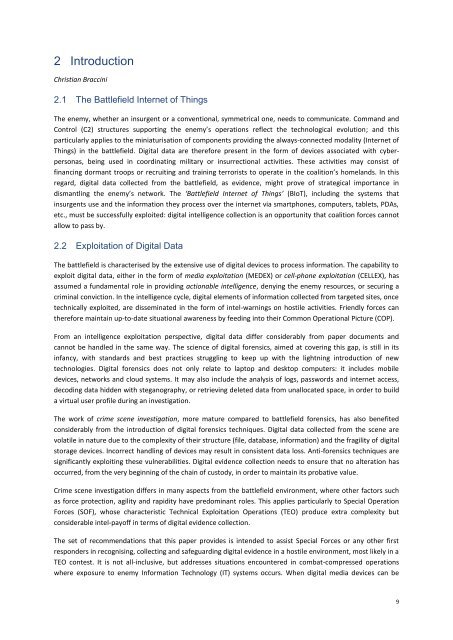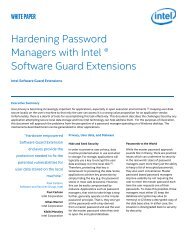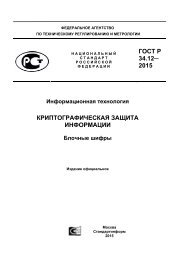BATTLEFIELD DIGITAL FORENSICS
BDF_Battlefield_Digital_Forensics_final
BDF_Battlefield_Digital_Forensics_final
You also want an ePaper? Increase the reach of your titles
YUMPU automatically turns print PDFs into web optimized ePapers that Google loves.
2<br />
Introduction<br />
Christian Braccini<br />
2.1 The Battlefield Internet of Things<br />
The enemy, whether an insurgent or a conventional, symmetrical one, needs to communicate. Command and<br />
Control (C2) structures supporting the enemy’s operations reflect the technological evolution; and this<br />
particularly applies to the miniaturisation of components providing the always-connected modality (Internet of<br />
Things) in the battlefield. Digital data are therefore present in the form of devices associated with cyberpersonas,<br />
being used in coordinating military or insurrectional activities. These activities may consist of<br />
financing dormant troops or recruiting and training terrorists to operate in the coalition’s homelands. In this<br />
regard, digital data collected from the battlefield, as evidence, might prove of strategical importance in<br />
dismantling the enemy’s network. The ‘Battlefield Internet of Things’ (BIoT), including the systems that<br />
insurgents use and the information they process over the internet via smartphones, computers, tablets, PDAs,<br />
etc., must be successfully exploited: digital intelligence collection is an opportunity that coalition forces cannot<br />
allow to pass by.<br />
2.2 Exploitation of Digital Data<br />
The battlefield is characterised by the extensive use of digital devices to process information. The capability to<br />
exploit digital data, either in the form of media exploitation (MEDEX) or cell-phone exploitation (CELLEX), has<br />
assumed a fundamental role in providing actionable intelligence, denying the enemy resources, or securing a<br />
criminal conviction. In the intelligence cycle, digital elements of information collected from targeted sites, once<br />
technically exploited, are disseminated in the form of intel-warnings on hostile activities. Friendly forces can<br />
therefore maintain up-to-date situational awareness by feeding into their Common Operational Picture (COP).<br />
From an intelligence exploitation perspective, digital data differ considerably from paper documents and<br />
cannot be handled in the same way. The science of digital forensics, aimed at covering this gap, is still in its<br />
infancy, with standards and best practices struggling to keep up with the lightning introduction of new<br />
technologies. Digital forensics does not only relate to laptop and desktop computers: it includes mobile<br />
devices, networks and cloud systems. It may also include the analysis of logs, passwords and internet access,<br />
decoding data hidden with steganography, or retrieving deleted data from unallocated space, in order to build<br />
a virtual user profile during an investigation.<br />
The work of crime scene investigation, more mature compared to battlefield forensics, has also benefited<br />
considerably from the introduction of digital forensics techniques. Digital data collected from the scene are<br />
volatile in nature due to the complexity of their structure (file, database, information) and the fragility of digital<br />
storage devices. Incorrect handling of devices may result in consistent data loss. Anti-forensics techniques are<br />
significantly exploiting these vulnerabilities. Digital evidence collection needs to ensure that no alteration has<br />
occurred, from the very beginning of the chain of custody, in order to maintain its probative value.<br />
Crime scene investigation differs in many aspects from the battlefield environment, where other factors such<br />
as force protection, agility and rapidity have predominant roles. This applies particularly to Special Operation<br />
Forces (SOF), whose characteristic Technical Exploitation Operations (TEO) produce extra complexity but<br />
considerable intel-payoff in terms of digital evidence collection.<br />
The set of recommendations that this paper provides is intended to assist Special Forces or any other first<br />
responders in recognising, collecting and safeguarding digital evidence in a hostile environment, most likely in a<br />
TEO contest. It is not all-inclusive, but addresses situations encountered in combat-compressed operations<br />
where exposure to enemy Information Technology (IT) systems occurs. When digital media devices can be<br />
9





